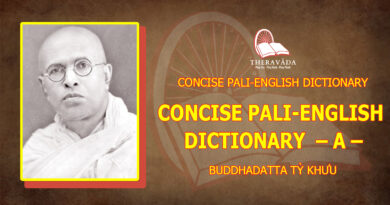A Modern Introduction To The Buddha’s Teaching – Chapter 8: Knowledge, Wisdom And Enlightenment – Dr Victor A. Gunasekara
CHAPTER 8: KNOWLEDGE, WISDOM AND ENLIGHTENMENT
The Buddha traced the root cause of suffering to ignorance; so the search for enlightenment is the supreme activity for the Buddhist (23). The activity proceeds at both the intellectual and the intuitive levels. Pure intellectual understanding is not sufficient, although it is often a very good starting point. When enlightenment is attained pure intellectual understanding is transcended by an intuitive grasp of the truths of the Universe.
If knowledge is the outcome of “intellectual” activity, a person’s fund of knowledge at any moment of time is made up of a number of beliefs that he considers valid. The Buddha was quite clear on what he considered legitimate to believe in. In his discourse to the Kalamas (a people who were confused by the diversity of viewpoints they were confronted with) the Buddha said:
“Come, O Kalamas, do not accept anything from mere hearsay, or from what you have been told, or because it is mentioned in sacred teachings, or because of logic merely, or because of its methods, or in consideration of plausible reasoning, or by tolerating views based on speculation, or because of its appearance of its possibility and because `your teacher is venerable’. But when you, Kalamas, realize by yourself that views are unwholesome, faulty, condemned by the wise, and that they lead to harm and misery when practised and observed, then Kalamas, you should reject them”
This is the criterion of acceptability which the Buddha wanted to apply to all claims, including his own. In Buddhism there cannot be room for blind faith, and all propositions, religious or otherwise should be subjected to analysis and practice. The reference to “mere logic” and “plausible reasoning” in the quotation given serves as a caution concerning some extreme forms of “rationalism” which argue that “pure reason” is sufficient to establish the truth of metaphysical propositions (like that of the existence of God). Deductive methods are useful, but as they can only bring out what is already contained in the premises of the argument, they cannot be used as a vehicle for the discovery of new truths. Rightly has the Kalamasutta been termed the Buddhist charter of free enquiry.
As a result of the Buddha’s rational and tolerant attitude early Buddhism never had concepts like heresy, apostasy and blasphemy (and this is true of all subsequent Buddhist schools). In many theistic systems imprisonment, torture and death have been inflicted on people who have refused to bow before dogma.
In Buddhist epistemology three levels of understanding are recognised. These are (using the Pali terminology): dii (“views”), ñâna “science”), and bodhi (“wisdom”). Dii refers to views accepted more or less dogmatically. Not all such beliefs are necessarily harmful, because some people could be motivated to act wholesomely even though motivated by incorrect views. But more usually such “views” can be extremely harmful(24) . The Buddha did not consider knowledge consisting of dii to be useful in the longer term. Dii is often contrasted with scientifically based knowledge, which results from thinking, from learning and from mental development. The acquisition of this kind of knowledge is useful, and is not discouraged; but it alone will not lead to enlightenment. This is clearly seen in the case of many eminent scientists, who have progressed far in the acquisition of particular kinds of knowledge, but have not been able to outgrow the dogmatic views inculcated in early childhood.
P>True enlightenment can arise out of the third kind of knowledge, consisting of wisdom (bodhi) and insight (vipassana). This results from the intuitive realisation of the Buddhist laws and truths after the successful traverse of the Middle Path. The enlightenment process involves the breaking of the ten fetters (sayojana) that bind people to the phenomenal world. These are the five lower fetters of personality belief, sceptical doubt, clinging to rite and ritual, sensuous craving and ill-will, and the five higher fetters of craving for “fine material” existence, craving for “immaterial existence”, conceit, restlessness, and ignorance.









